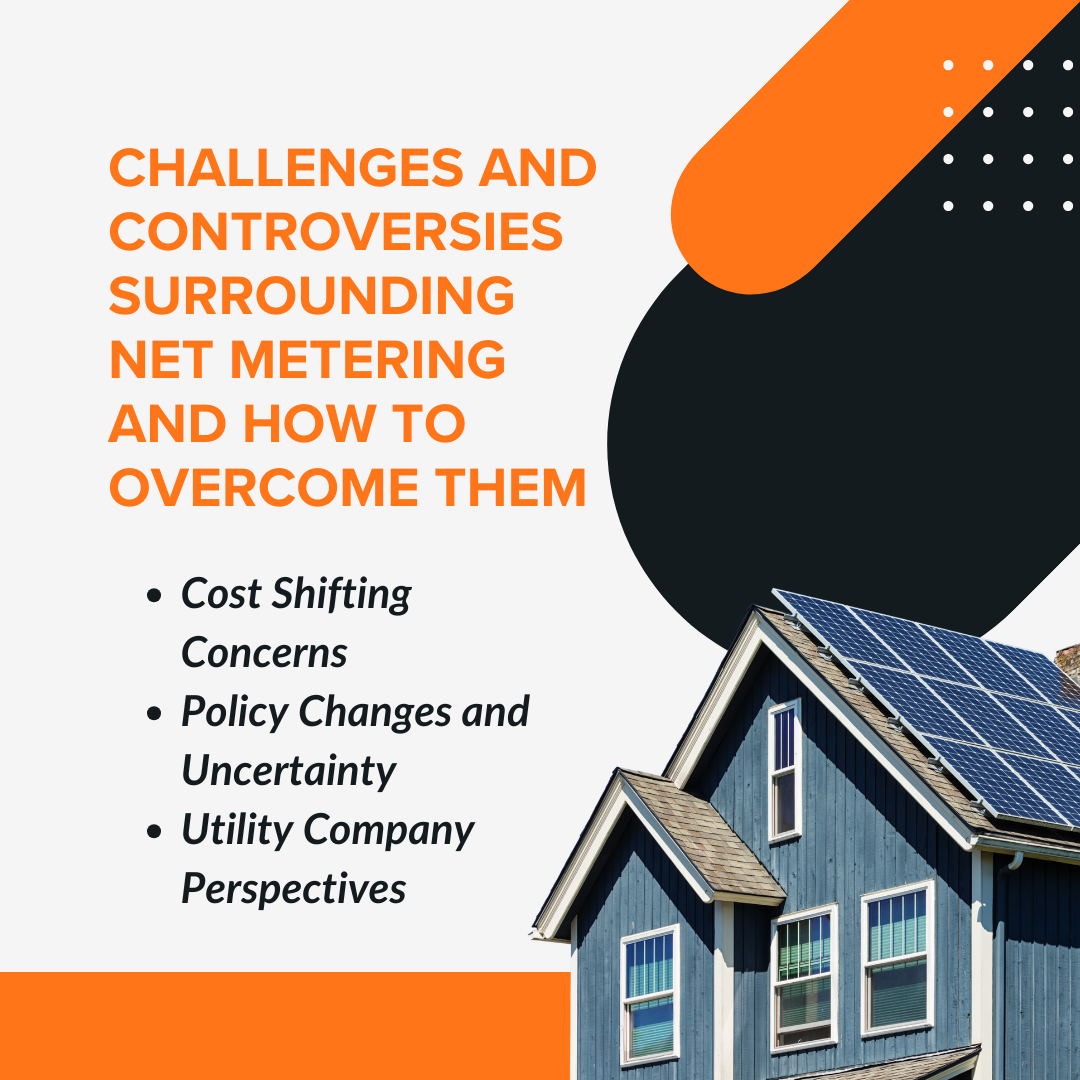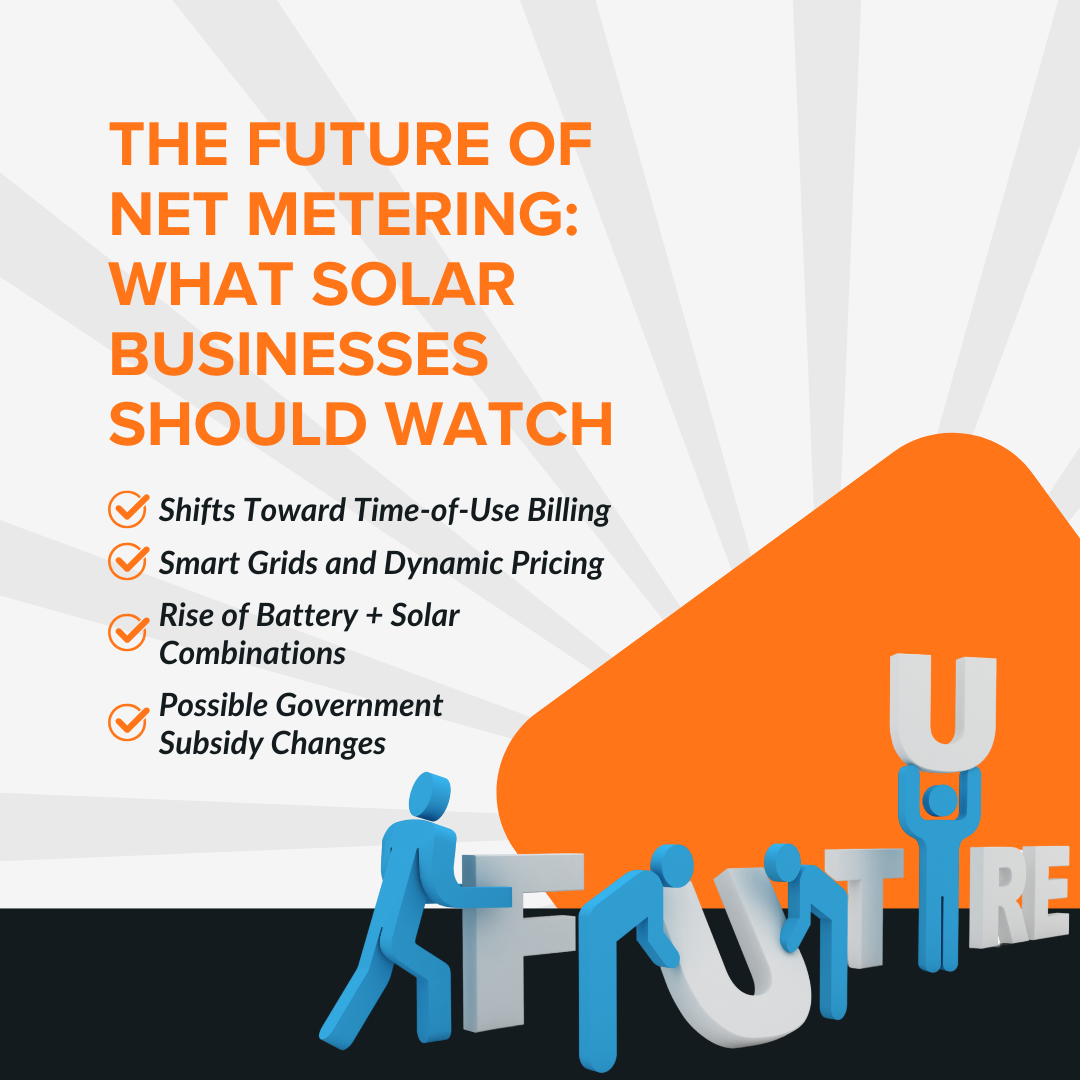June 3, 2025
When you hear someone talk about saving money with solar panels, chances are they’re talking about net metering, even if they don’t realize it.
Net metering is one of the most critical policies driving the adoption of solar energy across the U.S.
It’s a simple concept, but it has a significant impact on both homeowners and the businesses that help them go solar.
Let's see how net metering works, why it matters for solar businesses, and what to watch out for as policies evolve!
Key Takeaways
- Net metering is a billing system that gives solar panel owners credit for the excess electricity they send back to the electric grid.
- It boosts the return on investment for homeowners and increases demand for solar power systems.
- Changes to net metering policies can affect the attractiveness of solar power, so companies must stay informed and flexible.
What is Net Metering?
Net metering, also called net energy metering (NEM), is a billing mechanism that allows homeowners or businesses with solar systems to receive credits for excess energy their solar panels generate and send back to the electricity grid.
How does it work?
Here’s a simple breakdown:
- Your solar power system generates electricity during the day.
- If your system produces more electricity than you use at that moment, the surplus electricity is sent to the electric grid.
- Your electric meter runs backward, giving you net metering credits.
- You pull electricity from the grid at night or during cloudy days when your system isn’t producing enough.
- At the end of the billing period, you pay for your net energy use, which is energy consumed minus energy produced.
This setup means your electricity bill can significantly reduce or even drop to zero in some months.
Eligibility and Availability
Net metering systems are generally available to homeowners with grid-tied systems in states with active net metering programs. However, the rules can vary widely:
- Some states have mandatory net metering rules, while others allow utility companies to set policies.
- The size of the system that qualifies can also differ, as can the value of net metering credits.
It’s also worth noting that some states are shifting to net billing or other models as they revisit how net metering works.
What are the key terms to know about net metering?
Let's dive in!
1. Net Metering
Net metering is a billing policy that allows solar customers to receive electricity credits for any excess electricity their solar energy system sends back to the electric grid.
When your solar panels produce more energy than your home uses, the extra energy is exported to the grid, and you're credited usually at the retail rate on your electric bill.
These net metering credits can offset the cost of pulling electricity from the grid when your solar power system isn’t generating enough, like at night or on cloudy days.
It’s a cornerstone of net metering policies across many states and is vital in improving the financial returns of installing a solar system.
2. Grid-Tied System
A grid-tied system is a solar power system connected to the primary electricity grid, allowing electricity to flow to and from your home.
This setup enables net energy metering to work effectively. During the day, your solar panels may generate electricity in excess of your consumption, and surplus electricity is fed into the grid.
At night or during high-use periods, you can pull electricity back from the grid as needed.
These systems are the most common in residential solar installations. They eliminate the need for expensive battery storage and rely on the grid as a virtual battery through net metering programs.
3. Electricity Credits
Electricity credits, or net metering credits, are what you earn when your solar panels produce more energy than you use and send the excess to the utility company’s electricity grid.
Your electric meter tracks these credits, which appear on your billing period statement as a reduction in your owed amount.
Over time, these credits help balance your electricity usage and energy consumption, often significantly reducing your energy costs.
Depending on your state's net metering policies and your utility’s specific rules, these credits can sometimes roll over to offset future bills.
4. Feed-in Tariff
A feed-in tariff (FiT) is another way solar homeowners and businesses can be compensated for the energy generated by their solar panels.
Unlike traditional net metering, where you only get credit for the excess energy you don’t use, a feed-in tariff pays you a set price, usually per kilowatt hour, for every unit of electricity your solar system feeds into the distribution company’s grid, regardless of your consumption.
It’s often used in countries or regions that don’t support net metering. While it offers a predictable income for solar producers, the fixed rate is typically lower than the retail rate, which can affect the overall ROI of your solar power system.
Why Net Metering is a Big Deal for Homeowners?

1. Saves Money on Electricity Bills
Net metering allows homeowners to significantly reduce their electricity bills by using the electricity generated by their solar energy system instead of relying solely on utility electricity.
When solar panels produce more electricity than the home consumes, especially during sunny afternoons, this excess electricity is sent to the electricity grid, and homeowners earn net metering credits.
These credits offset the electricity pulled from the grid at night or during low-sunlight periods, reducing the electric bill and sometimes eliminating it entirely. Over time, this can lead to thousands in savings and greater energy independence.
2. Faster ROI on Solar Investment
Homeowners participating in net metering programs can recover their upfront solar investment much faster.
The financial return becomes more attractive by receiving full or near-retail value for the excess energy their solar power system generates and sends back to the grid.
Net energy metering is crucial in improving ROI by maximizing the economic value of every kilowatt hour of solar
electricity produced.
This means the solar system powers the home and helps pay for itself by reducing ongoing energy costs, making solar a wise, long-term investment.
3. Encourages Energy Efficiency
One of the often-overlooked benefits of net metering is the behavioral change it sparks.
When homeowners start tracking how much electricity their solar panels produce versus how much they consume, they naturally become more energy-conscious.
Seeing the direct impact of energy habits on net kilowatt-hour usage and future bills motivates people to reduce consumption, upgrade to efficient appliances, and avoid wasteful practices.
This leads to a more efficient household and ensures that the value of their solar panels is fully realized.
4. Acts Like a Battery Without the Cost
While battery storage is a growing trend in solar, it's not financially accessible to everyone. Solar net metering offers a cost-effective alternative.
Instead of storing unused energy onsite, homeowners can feed surplus electricity back into the electric grid and
earn net metering credits.
These credits balance consumption when solar panels aren't producing power, such as at night or during storms.
It's like having a virtual battery that stores energy value instead of electrons without the upfront cost, maintenance, or space requirements.
This makes solar electricity more flexible, especially for customers who want storage benefits without the added expense.
For more information on integrating solar software, check out our complete guide on Integrating Solar Software into Your Daily Workflow
How Solar Companies Can Leverage Net Metering?

A. Educate Customers Clearly
Many homeowners are unfamiliar with net metering systems, so it's essential to break it down in simple terms during your solar sales pitch.
Use everyday language to explain how solar panels produce more electricity than a home might use during the day, and how this excess electricity gets sent back to the grid.
Let them know that through net energy metering, they earn electricity credits, essentially turning their solar power system into a mini power plant.
Pro tip: The clearer your explanation, the more likely customers are to trust the process and see the value in
solar.
B. Include Net Energy Metering in ROI Calculations
When walking potential clients through the numbers, consider how net metering credits will offset their future electric bills.
Showing projections over the billing period, demonstrating how much energy their solar energy system generates, will reduce their monthly electricity usage costs.
Including these figures can significantly enhance the perceived return on investment (ROI), making solar more financially compelling.
By showing how net metering allows homeowners to pay less for energy over time, you're making the decision to go solar much easier.
C. Work with Local Utility Providers
Navigating state net metering policies and dealing with utility companies can overwhelm the average homeowner.
Partner with local utility providers to streamline the application and approval process for net-metered systems.
This shortens the timeline for solar installations and boosts your reputation as a supportive and knowledgeable partner.
Knowing you’ll handle the paperwork and coordination with the distribution company makes the entire experience more seamless for your customers.
D. Use Net Metering as a Lead Magnet
Net metering is one of the most powerful, yet misunderstood aspects of going solar, making it a tremendous educational hook.
Create high-value blog posts, short videos, or explainer webinars like “How Net Metering Works” or “Why Net Metering Saves You Money.”
Promote these across social media and paid ads to attract solar-curious homeowners. Once they understand that net metering policies let them lower or eliminate their electric bills using solar net metering credits, they’re far more likely to engage with your brand and become qualified leads.
Find out the Importance of solar system design in optimizing energy production.
Challenges and Controversies Surrounding Net Metering and how to overcome them

1. Cost Shifting Concerns
Some claim that solar customers benefiting from net metering credits aren't covering their share of grid maintenance costs.
This has led to concerns about cost shifting, where non-solar utility customers may pay more.
However, distributed generation systems like rooftop solar help reduce peak load and improve overall grid efficiency.
Solar companies should educate stakeholders on how solar power systems can benefit all utility customers, not just the owners.
2. Policy Changes and Uncertainty
Recent shifts in net metering policies, like those in California and Florida, have reduced incentives for new solar installations.
These changes can create uncertainty for solar homeowners and businesses planning long-term investments.
Solar companies must stay informed on evolving state net metering policies and legislative trends.
Proactively offering alternatives such as battery storage or virtual net metering can help mitigate these impacts.
3. Utility Company Perspectives
Many utility companies, especially investor-owned utilities, argue that widespread net metering systems affect their revenue model.
They also voice concerns about grid stability as more solar panels generate and feed power into the electricity grid. This highlights the need for solar firms to work alongside utilities to support grid modernization efforts.
Solar businesses can help shape fair, forward-thinking net metering programs through collaboration and open communication.
The Future of Net Metering: What Solar Businesses Should Watch

A. Shifts Toward Time-of-Use Billing
Modern net metering programs often assign value to excess electricity based on when it’s fed into the electric grid. Energy sent during high-demand hours earns more credits, making strategic generation even more critical.
Solar customers should understand how time-of-use affects their net metering credit value.
This shift encourages more innovative energy use and more optimized solar system performance.
B. Smart Grids and Dynamic Pricing
As smart grids evolve, dynamic energy pricing is becoming the new normal. Solar companies must help customers adapt to changing electricity usage patterns and rates.
Monitoring how and when energy is consumed and fed to the grid will be key to maximizing savings.
This presents an opportunity to offer value-added services and smarter solar power system setups.
C. Rise of Battery + Solar Combinations
With lower net metering caps and reduced credit rates in some states, battery storage is rising.
Homeowners now prefer to store excess power rather than sending it to the grid at lower returns.
Combining solar electricity with battery solutions boosts energy independence and long-term savings.
It’s a chance for solar companies to expand offerings and stay competitive in a shifting market.
D. Possible Government Subsidy Changes
Fluctuations in state and federal subsidies could reshape the net metering policy landscape.
Solar companies must stay informed and educate homeowners about potential changes in benefits. Adapting to updated incentives ensures the continued viability of solar net metering credits.
For further information, check out this blog: Adjusting to the 2025 Solar Policy Updates.
Final Thoughts
Net metering has made solar power accessible and financially viable.
For solar businesses, it’s both a selling point and a policy to monitor closely.
Companies can thrive even as the rules shift by educating customers, working with utilities, and adapting to change.
Empower Your Solar Business with Sunbase
Balancing sales, design, proposals, project management, and more! Sunbase Solar Software charges your entire solar business.
Save time. Increase efficiency. Expand your business.
Book a demo
here!
I agree to receive marketing messaging from Sunbase at the phone number provided above. I understand data rates will apply, and can reply STOP to OPT OUT.











